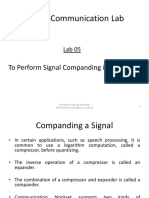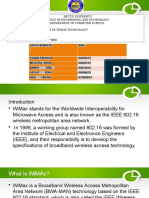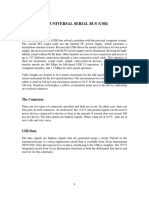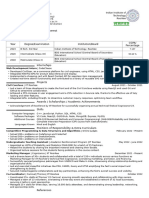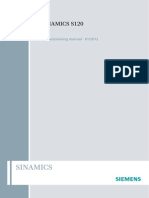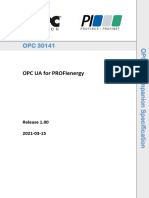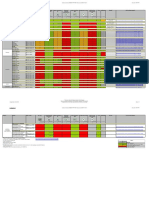How Profibus Communication Works
How Profibus Communication Works
Uploaded by
RALPH JULES SARAUSCopyright:
Available Formats
How Profibus Communication Works
How Profibus Communication Works
Uploaded by
RALPH JULES SARAUSCopyright
Available Formats
Share this document
Did you find this document useful?
Is this content inappropriate?
Copyright:
Available Formats
How Profibus Communication Works
How Profibus Communication Works
Uploaded by
RALPH JULES SARAUSCopyright:
Available Formats
How Profibus Communication
Works
by
Introduction to Profibus
If Modbus is the “granddaddy” of protocols, then Profibus is the
young athlete – lean and fast. Profibus was designed in the 1990s to
meet all industrial communication needs for both factory and process
automation (Figure 1). As with Modbus, there are a number of terms
associated with this protocol: Profibus DP, Profibus PA, Profisafe,
Profidrive, and Profinet. One way of visualizing how these terms fit
together is to think of Profibus as a book with many chapters. The
book would be called Profibus DP (Decentralized Peripheral). The
book’s chapters would be called Profibus PA (Process Automation),
Profisafe for safety application, and Profidrive for high-speed drive
applications. In addition, there would be a second book by the same
authors called Profinet, with many chapters, including Profisafe and
Profidrive.
Also Read: How Modbus Communication Works
Fig 1 :
Profibus network
How does Profibus work?
Profibus is also a master-slave type protocol like Modbus but with an
additional token ring protocol to allow for multiple masters. Also,
unlike Modbus, all devices go through a startup sequence during
which they “join” the network. Each slave maintains a failsafe timer. If
the master does not talk to it within a certain time limit, the slave goes
into a safe state; the master must then go through the startup
sequence again before further data exchange can occur. This, in
combination with a watchdog timer in the master, ensures that all
communication occurs every bus cycle with a certain time value.
The general bus scan would happen as shown in Figure 2. Master A
receives the token, which gives it control of the bus. It will then
exchange data with each of its slaves, and when complete, pass on the
token to the next master (if there is one). The requirement for
detailed diagnostics from each slave is also built into the protocol.
During normal data exchange, a slave can alert the master that it has
diagnostics, which the master will then read during the next bus scan.
Fig 2 :
Profibus scan
Profinet is built on the same principle as Profibus. But unlike Modbus –
which basically took the Modbus RTU packet and encapsulated it into
a TCP/IP packet – Profinet was designed to take advantage of Ethernet
and permit easy addition of higher-end Profibus functions like
Profisafe.
Physical layer
The main physical layer for Profibus DP is based on RS-485, which
Modbus uses. However, in the case of Profibus, the Profibus
specification does not simply refer to the existing RS-485 specification.
Instead, it extends the RS-485 specification. The physical layer was
tightened up to require only two wires, with speeds as fast as 12
megabits per second. The Profibus specification also standardized the
connectors to be used. All of this is beneficial when working with
multiple vendors – wiring is easy and consistent.
For instrumentation, Profibus PA also has another physical layer called
IEC 61158-2, Manchester Encoded, bus-powered, intrinsically safe
(MBP-IS). This physical layer provides power and communications on
the same two wires. The intrinsically safe concept has a big advantage
when it comes to installation costs. Working with hazardous
environments, there are two approaches: The power going to the
instrument in the hazardous area can be contained, or the power
going out into the hazardous area can be limited. The containment
method is the traditional one and the one that is required for Modbus.
It uses a metal conduit and seals to “contain” the energy. Both the
conduit and seals are expensive to buy and install. The second
approach is used by Profibus PA. It limits the power going to the field
and is considered intrinsically safe. With it, no conduits or seals are
needed (except maybe at the starting cabinet), resulting in significant
cost savings.
Profibus noise immunity
Both of Profibus’ main physical layers (modified RS-485 and MBP-IS)
are highly detailed and have excellent noise immunity, proven over
and over again at countless sites. Once Profibus is designed and
installed properly, it is next to bulletproof.
Standardized outputs and function block design
For instrumentation, there is a part of the Profibus standard called the
profile standard, which is a standardization of an instrument from the
point of view of the bus. It defines not only standard inputs and
outputs, but also functions and functionalities that are within the
instrument. This helps in both the setup and integration of field
instruments and allows for easy multi-vendor applications.
For example, the output from all Profibus PA transmitters is five bytes
long. The first four bytes are the IEEE floating point value of the
process variable. The fifth byte is the status byte that indicates
whether or not the process variable can be trusted. The major status
codes are all standardized in the specification. A value of x80, for
example, indicates that everything is okay. This applies to all
transmitters from all manufacturers [Figure 3]. This significantly lowers
the amount of engineering required for device integration. Whereas
with Modbus, every device’s data and diagnostics are completely
individualized and must be adapted, this is not the case with Profibus.
Fig 3 : Profibus PA
standardized output
Use with modems
Profibus DP and Profinet both have tight timing constraints. However,
a number of vendors have been able to make a variety of modems
(phone lines, wireless, cell) work well with both of them.
Typical applications
Profibus was designed to automate an entire plant, regardless of its
size or whether the plant is factory automation (composed of discrete
input/output) or process automation (made up of analog
input/output). It also does not matter if all the sections are local or
remote: Profibus can handle it all well.
Profibus Types
The Profibus family consists of three compatible versions: Profibus-DP,
Profibus-PA and Profibus-FMS.
Profibus-DP – Optimized for high speed and inexpensive
hookup. DP version is designed especially for communication
between automation control systems and distributed I/O at the
device level. Can be used to replace parallel signal
transmission with 24 V or 0 to 20 mA. This is the only card
that will be supported in this specification document.
Profibus-PA – Designed especially for process automation. It
permits sensors and actuators to be connected on one
common bus line even in intrinsically safe areas. Permits data
communication and power over the bus using 2-wire
technology according to the international standard IEC 1158-
2. Will not be implemented in this spec because only I/O will
be controlled.
Profibus-FMS – General-purpose solution for communication
tasks at the cell level. Powerful FMS services open up a wide
range of applications and provide great flexibility. Can also be
used for extensive and complex communication tasks. Will not
be implemented in this spec because CODE provides much of
the same function.
Advantages of Profibus PA
The introduction of PROFIBUS PA has closed the gap of digital data
communication between automation systems and field devices. The
improved functionality of PROFIBUS PA offers advantages through all
stages of a project:
During Installation Phase
Reduced wiring, and therefore, ease of engineering and installation
Faster assembly and reduced faults
Material saved for cabling
Instruments can be installed in locations close to the process for direct
measurement; information is accessible remotely, daily access is not
necessary
During Commissioning Phase
More than 100 devices can be commissioned per day
One person can complete commissioning; no need for a second
person in the field to find and “activate” an instrument for the
loop check
Communication faults can be located from the control room
No 4-20mA calibration is required since the digital device
measures the full range of process values
Instrument settings can be downloaded from the control room;
no need to connect a handheld to each transmitter individually
During Maintenance Phase
Diagnostic information for predictive maintenance; maintenance
is performed only when scheduled or required
Determination of process or instrument faults
Easy and fast troubleshooting from the control room
No need to find the instrument in the plant
Fewer trips to the field
Self-test and corrective functions in the field device
No periodic 4-20 mA calibration
Plug and play by downloading replaced instrument settings to
the new instrument
Profibus Benefits
You might also like
- ECE4003 Embedded-System-Design ETH 1 AC40Document3 pagesECE4003 Embedded-System-Design ETH 1 AC40Grace ARORANo ratings yet
- NCU Diagnostic Displays and Switches: TatusDocument3 pagesNCU Diagnostic Displays and Switches: TatusBam BANo ratings yet
- Embedded SystemsDocument21 pagesEmbedded Systemsmalhiavtarsingh100% (2)
- ES QA NotesDocument91 pagesES QA NotesPratik PatilNo ratings yet
- 1-Microcontroller Based System Design - CompleteDocument58 pages1-Microcontroller Based System Design - Completerizwan9000% (1)
- Consumer Electronics PDFDocument22 pagesConsumer Electronics PDFXYZNo ratings yet
- Fingerprint Based Electronic Voting MachineDocument20 pagesFingerprint Based Electronic Voting MachineAnjali yadavNo ratings yet
- Lab 05 To Perform Signal Companding in SimulinkDocument15 pagesLab 05 To Perform Signal Companding in SimulinkArshad AliNo ratings yet
- Term Paper On Embedded SystemDocument11 pagesTerm Paper On Embedded Systemsupreetsingh1960% (1)
- MMC Chap5Document11 pagesMMC Chap5SOMESH B S100% (1)
- 8051Document69 pages8051Raffi SkNo ratings yet
- WI MAX TechnologyDocument25 pagesWI MAX TechnologyGatlat Deng PuochNo ratings yet
- Computernetworking LAB REPORTDocument7 pagesComputernetworking LAB REPORTmigadNo ratings yet
- Ece MPMCDocument19 pagesEce MPMCdukeNo ratings yet
- Basic ARM9 Block DiagramDocument2 pagesBasic ARM9 Block Diagramhumtum_shri100% (1)
- Module 2 VirtualizationDocument65 pagesModule 2 VirtualizationJust Watch ItNo ratings yet
- Unit 3 Programmable Digital Signal ProcessorsDocument25 pagesUnit 3 Programmable Digital Signal ProcessorsPreetham SaigalNo ratings yet
- ARM Parallel IODocument34 pagesARM Parallel IOAaaa AaaaNo ratings yet
- Lecture Nine 8086 Microprocessor Memory and I/O Interfacing: March 2020Document23 pagesLecture Nine 8086 Microprocessor Memory and I/O Interfacing: March 2020ally0% (1)
- Ahb To Apb NotesDocument13 pagesAhb To Apb NotesAbhimanyuNo ratings yet
- LPC 2378 Development BoardDocument160 pagesLPC 2378 Development BoardDinesh KumarNo ratings yet
- Rajagiri School of Engineering and TechnologyDocument44 pagesRajagiri School of Engineering and TechnologyBennet MathewNo ratings yet
- Chapter 2 ARM Cortex-M3 Architecture - 3Document68 pagesChapter 2 ARM Cortex-M3 Architecture - 3Weehao SiowNo ratings yet
- AdHoc NetworksDocument34 pagesAdHoc NetworksDecent Nil100% (1)
- Embedded System LESSONPLANDocument7 pagesEmbedded System LESSONPLANgallantprakashNo ratings yet
- Chapter 2 PowerpointDocument86 pagesChapter 2 Powerpointhassan salehNo ratings yet
- 2 Programming Model and PipeliningDocument40 pages2 Programming Model and PipeliningHiteshNo ratings yet
- Instruction PipelineDocument27 pagesInstruction PipelineEswin AngelNo ratings yet
- A Design Implementation and Comparative Analysis of Advanced Encryption Standard (AES) Algorithm On FPGADocument4 pagesA Design Implementation and Comparative Analysis of Advanced Encryption Standard (AES) Algorithm On FPGAAnand Parakkat Parambil100% (1)
- Virtual Instrumentation PPT Persentation Way2project inDocument16 pagesVirtual Instrumentation PPT Persentation Way2project inSharan ShivaNo ratings yet
- 10 BDocument24 pages10 Bhassan_said_8No ratings yet
- Unit-4: Iot Architecture and ProtocolsDocument22 pagesUnit-4: Iot Architecture and ProtocolsMahesh ChauhanNo ratings yet
- Important Instructions To Examiners:: (Autonomous)Document29 pagesImportant Instructions To Examiners:: (Autonomous)Rohit Shinde RSNo ratings yet
- Network Lab PDFDocument83 pagesNetwork Lab PDFSuhaibb Masalha100% (1)
- Automatic Fall Detector For ElderlyDocument25 pagesAutomatic Fall Detector For ElderlyTheertham Ravi TejaNo ratings yet
- 8 Virtualization Distributed Systems and MiddlewareDocument89 pages8 Virtualization Distributed Systems and MiddlewareDIEGO SEBASTIAN DURAN LANDEROSNo ratings yet
- The Universal Serial BusDocument11 pagesThe Universal Serial BusHiba AbdulwahedNo ratings yet
- 09 - I2C Serial CommunicationsmDocument10 pages09 - I2C Serial CommunicationsmSorabh DungNo ratings yet
- Difference Between Harvard and Princeton or Von Neumann ArchitectureDocument3 pagesDifference Between Harvard and Princeton or Von Neumann ArchitectureTarek Bin Zahid75% (4)
- EC6703 Embedded and Real Time SystemsDocument168 pagesEC6703 Embedded and Real Time Systemsramkumar100% (1)
- Software Development ProcessDocument6 pagesSoftware Development ProcessSoundarya SvsNo ratings yet
- Unit - 5 Serial CommunicationDocument51 pagesUnit - 5 Serial CommunicationM.venkateshNo ratings yet
- IOT Lab ManualDocument94 pagesIOT Lab Manualmendaharshitha2004No ratings yet
- Module 1 ACADocument42 pagesModule 1 ACARupesh Sapkota86% (7)
- Vmebus Basics: Diagram of Vmebus ComponentsDocument14 pagesVmebus Basics: Diagram of Vmebus ComponentsErasmo Franco SNo ratings yet
- DS AkashDocument33 pagesDS AkashBhavesh Kumar 1019No ratings yet
- Real-Time Operating Systems: Part 1: Mars Pathfinder 1997Document159 pagesReal-Time Operating Systems: Part 1: Mars Pathfinder 1997Khalid FaharaNo ratings yet
- IoT Lab REPORT CSEDocument20 pagesIoT Lab REPORT CSECaptains PlayNo ratings yet
- 8 Complex Systems & Microprocessors Part IIDocument17 pages8 Complex Systems & Microprocessors Part IIRahul S.KumarNo ratings yet
- Hiperlan: HI PE R L A NDocument36 pagesHiperlan: HI PE R L A NRajarshi Pal ChowdhuryNo ratings yet
- PPT-3 8088 8086 PinDocument53 pagesPPT-3 8088 8086 PinMadhav Singh100% (1)
- Design and Construction of LED Matrix DisplayDocument7 pagesDesign and Construction of LED Matrix DisplayTseren TsekuNo ratings yet
- Digital Thermometer Using 8051 Microcontroller Project ReportDocument18 pagesDigital Thermometer Using 8051 Microcontroller Project ReportZakaria BelyamaniNo ratings yet
- Finger Print Based Electronic Voting MachineDocument88 pagesFinger Print Based Electronic Voting MachineShakir Rahmani100% (1)
- Unit - I - ARM Processor - Dr. M. R. ArunDocument3 pagesUnit - I - ARM Processor - Dr. M. R. ArunArun John M R100% (1)
- Qualcomm India Pvt. Ltd. (Engineer - HW - SW) - 20113153 - ResumeDocument2 pagesQualcomm India Pvt. Ltd. (Engineer - HW - SW) - 20113153 - Resumedummy.shobhit.johriNo ratings yet
- Lecture 04 - Industrial Communication SystemsDocument38 pagesLecture 04 - Industrial Communication SystemsChamal PraveenNo ratings yet
- Module 1 Notes (17EC81)Document16 pagesModule 1 Notes (17EC81)gagan mrNo ratings yet
- PLC and HMI Development with Siemens TIA Portal: Develop PLC and HMI programs using standard methods and structured approaches with TIA Portal V17From EverandPLC and HMI Development with Siemens TIA Portal: Develop PLC and HMI programs using standard methods and structured approaches with TIA Portal V17No ratings yet
- EE16704 UNIT5 ProfibusDocument29 pagesEE16704 UNIT5 ProfibusthamizmaniNo ratings yet
- Profibus Communication Interview Questions & Answers Instrumentation ToolsDocument19 pagesProfibus Communication Interview Questions & Answers Instrumentation ToolsProcurement PardisanNo ratings yet
- Plumbing Vent DefinitionsDocument33 pagesPlumbing Vent DefinitionsRALPH JULES SARAUSNo ratings yet
- BMP Mis or 1 - Process Improvement 2023Document9 pagesBMP Mis or 1 - Process Improvement 2023RALPH JULES SARAUSNo ratings yet
- New DTM Interface Simplifies PLC ProgrammingDocument4 pagesNew DTM Interface Simplifies PLC ProgrammingRALPH JULES SARAUSNo ratings yet
- Pulley Belt CalculationsDocument5 pagesPulley Belt CalculationsRALPH JULES SARAUSNo ratings yet
- Pulleys CalculationDocument21 pagesPulleys CalculationRALPH JULES SARAUS100% (1)
- The Difference Between Full Thread Bolt and Partial Thread Bolt UsesDocument2 pagesThe Difference Between Full Thread Bolt and Partial Thread Bolt UsesRALPH JULES SARAUSNo ratings yet
- FHPP Positioning Library Step7 enDocument42 pagesFHPP Positioning Library Step7 enMartin GuzmanNo ratings yet
- SinamicsDocument9 pagesSinamicslaurentiu floreaNo ratings yet
- Siemens Simatic Step 7 Programmers HandbookDocument64 pagesSiemens Simatic Step 7 Programmers HandbookMario BorgiattinoNo ratings yet
- SERV1 01E SystemFamilyDocument44 pagesSERV1 01E SystemFamilynyamai20008234100% (1)
- Pcs7 Profinet Blueprints Doc en 91sp2Document128 pagesPcs7 Profinet Blueprints Doc en 91sp2ahmad jouriehNo ratings yet
- S7-300 - Hardware and InstallationDocument250 pagesS7-300 - Hardware and InstallationTetsusaigaNo ratings yet
- En Fpno-21 Um CDocument184 pagesEn Fpno-21 Um CssummersNo ratings yet
- Commissioning Manual SINAMICS S120Document274 pagesCommissioning Manual SINAMICS S120Nguyễn Thế AnhNo ratings yet
- Product Data Sheet Pac8000 Emerson en 6156702Document7 pagesProduct Data Sheet Pac8000 Emerson en 6156702zakaria nouiNo ratings yet
- Siemens CU240B 2 CU240E 2 ManualDocument364 pagesSiemens CU240B 2 CU240E 2 Manualangelboy_20No ratings yet
- Cisco Industrial Ethernet 4000 Series SwitchesDocument20 pagesCisco Industrial Ethernet 4000 Series SwitchesgoaltodayNo ratings yet
- 520com Um005 - en PDocument88 pages520com Um005 - en PFanny LDNo ratings yet
- SINAMICS Drives: Sinamics G110, Sinamics G120 Standard Inverters Sinamics G110D, Sinamics G120D Distributed InvertersDocument245 pagesSINAMICS Drives: Sinamics G110, Sinamics G120 Standard Inverters Sinamics G110D, Sinamics G120D Distributed InvertersAngheloOchoaNo ratings yet
- s7300 Module Data Manual en-US en-USDocument676 pagess7300 Module Data Manual en-US en-USAsif ShahNo ratings yet
- EDS-405A 408A Series PDFDocument2 pagesEDS-405A 408A Series PDFSecret64No ratings yet
- OPC 30141 - UA CS For PROFIenergy v1.00Document69 pagesOPC 30141 - UA CS For PROFIenergy v1.00KahkashanNo ratings yet
- Datasheet SerpensDocument1 pageDatasheet SerpenshalilflztvNo ratings yet
- Ethernet-Based Industrial Communication ProtocolsDocument40 pagesEthernet-Based Industrial Communication Protocolsracordoba100% (3)
- PCS7 PROFINET Devices Overview V1 1 enDocument2 pagesPCS7 PROFINET Devices Overview V1 1 enpmmdavidNo ratings yet
- Geared Motors Power Distribution: V V V VDocument2 pagesGeared Motors Power Distribution: V V V VShamim Ahsan ParvezNo ratings yet
- DELTA IABG C EN 20220420 WebDocument160 pagesDELTA IABG C EN 20220420 WebALVINNo ratings yet
- DB 1436 GBDocument28 pagesDB 1436 GBclaudineiNo ratings yet
- 3BSE035981-600 A en System 800xa Control 6.0 AC 800M Binary and Analog Handling PDFDocument670 pages3BSE035981-600 A en System 800xa Control 6.0 AC 800M Binary and Analog Handling PDFFelix Eduardo Ossorio GarciaNo ratings yet
- Yaskawa Drive: User InstructionsDocument29 pagesYaskawa Drive: User InstructionsNGUYEN HUU DAONo ratings yet
- IO SystemDocument256 pagesIO SystemHayLenLeeNo ratings yet
- Profinet: Guideline Installation Guideline PROFINET Part 2: Network ComponentsDocument18 pagesProfinet: Guideline Installation Guideline PROFINET Part 2: Network ComponentsMarcos Paulo Menezes SilvaNo ratings yet
- Smart Measurement Technology For Smart FactoriesDocument16 pagesSmart Measurement Technology For Smart FactoriesaleNo ratings yet
- 2PAA109967-514 D en System 800xa 5.1 RevE Feature Pack 4 Release NotesDocument268 pages2PAA109967-514 D en System 800xa 5.1 RevE Feature Pack 4 Release NotesRubelinho PomaNo ratings yet
- Service Instructions: MEAG FieldbusDocument322 pagesService Instructions: MEAG Fieldbusjulianotbovi01No ratings yet







